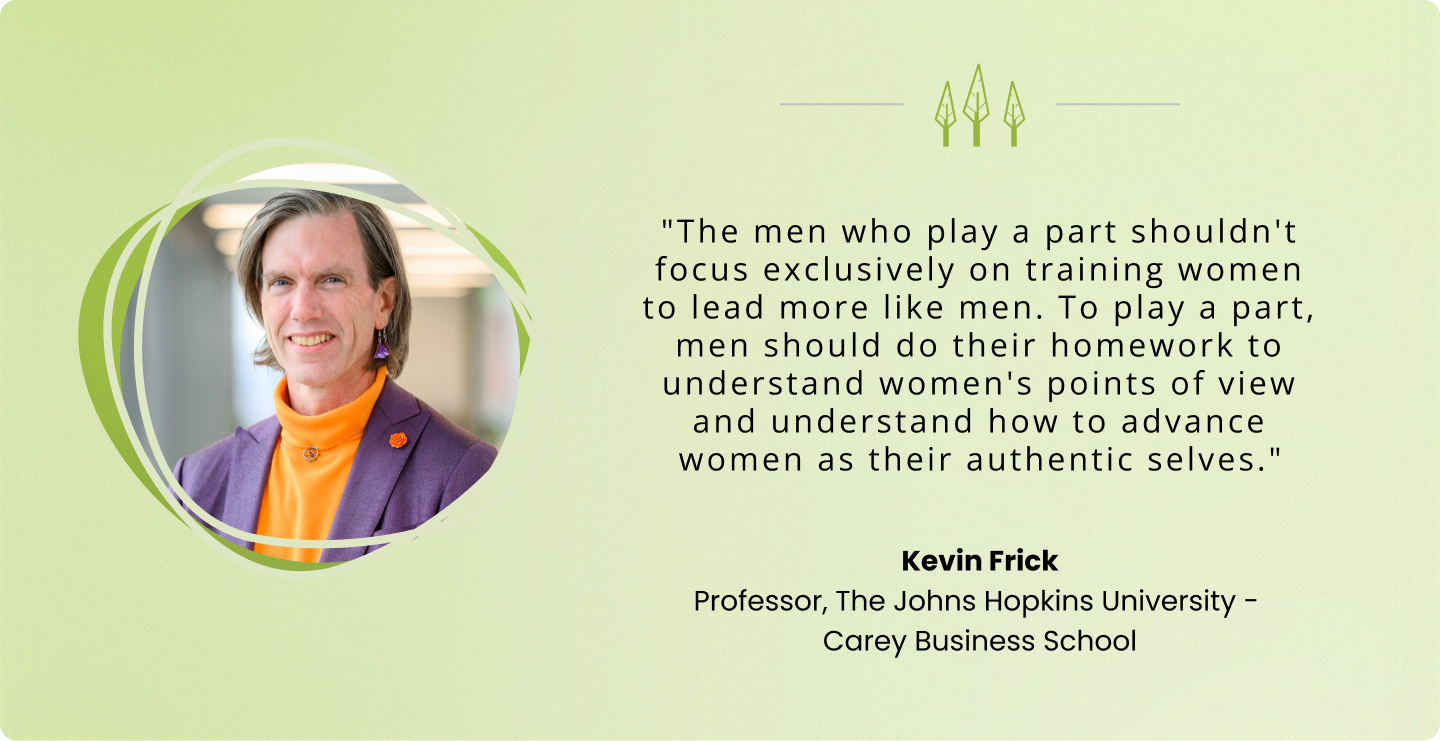The lack of women in STEM+ management doesn’t just happen. It’s a systemic issue rooted in unconscious bias, barriers that fuel gender imbalance, and fear of change. Many women find themselves deprived of real opportunities for growth, despite their exceptional skills and qualifications.
A closer look at the numbers shows that the STEM+ industries have learned to talk the talk, but they still need support to implement real change.
In the US, women only make up 34% of the science and engineering workforce and are twice more likely than women in other industries to quit their jobs. And in many countries, the stats are even worse. The dynamic remains overshadowed by surface-level DEI initiatives, making it difficult to have honest conversations about women in management.
So, how do we address these silent struggles? How can organizations forge a path toward a more equitable future? We asked 15 STEM+ leaders and Gotara Elite Advisors to share techniques to dismantle the invisible walls.
Here’s how we can build work environments where women are present and empowered to pursue management careers.

Drive Change with Data
Change starts with top management support, explains Board Chair at Refugee Artisan Initiative, Yumiko Damashek: “Top management needs to fully commit to women’s leadership development (vs. just playing a numbers game). They need to lead and fund the relevant programs to create a systemic change.”
Bringing C-suites on board is easier when DEI initiatives track ROI. So, you can use metrics to show how a shift in mentality impacts innovation and productivity.
Andi White, Head of Global Business Operations and Strategy at Microsoft, suggests opening the conversation with the benefits of having more women in leadership roles. “To help women achieve leadership positions, we need to actively promote their voices, successes, and stories, highlighting the unique qualities they bring to the table,” White says.

Tell The Story Behind The Numbers
Organizations with diverse management teams see an approximately 20% increase in innovation revenues. That’s because, as senior executives, women are more likely to invest in research and development instead of using mergers and acquisitions to buy innovation.
But there’s more to it than hits the eye. “The diversity, different mindset, breakthrough thinking, and various perspectives, enriches the discussion and helps achieve the desired results,” explains Alejandro Tapia, Associate Management Advisor.
We get similar data from Gartner. Diverse organizations demonstrate a 12% difference in employee performance compared to non-diverse organizations. And this change fuels growth in multiple business areas.
As an investor and a woman leader, Board Member and Business Advisor Karen Leeker can attest to the effectiveness of diverse leadership teams: “Gender diversity in leadership can bring about significant benefits to companies, including improved innovation, increased financial performance, and higher employee engagement.”
If we want more women in leadership roles, we must use such numbers to combat hiring discrimination.
“It’s important to create clear short-term and long-term goals, track the progress, and publish the results for the whole employee base.” — Yumiko Damashek, Board Chair at Refugee Artisan Initiative
The moral imperative for promoting diversity and inclusion is undeniable. However, presenting the financial benefits is more likely to be a persuasive catalyst for action. When top management understands the tangible benefits of diverse and inclusive workplaces, they become more inclined to allocate resources and champion DEI initiatives.

Fix The Broken Rung
The STEM+ challenge: only 52 women are promoted to management roles for every 100 men.
To combat the phenomenon known as the broken rung, companies should look at the representation of women at different levels of management and find where significant drop-offs occur.
Global Go-To-Market Growth Consultant Suzanne Rurode advises companies to empower women from day one and build career paths that anticipate the speed of growth to generate individual and business ROI.
“It’s easy to spot the women who will be high-flyers. They need to be given opportunities ‘just before’ they are ready for them because they will rise to the occasion and create brilliant results,” explains Rurode.
She also highlights that it takes more than upskilling to change things.

To truly embrace their leadership potential, women require support and encouragement from their teams. Unfortunately, the current reality is one where women are likely to face persistent undermining.
Women in STEM+ face hurdles that their men counterparts may not even be aware of. 50% of women in technical fields reported gender discrimination as compared to 19% of men.
According to Niamh Sproul, Employee Experience & Engagement Leader at Covetrus, companies that aim to fix the broken rung must revise anti-discrimination policies to ensure they extend to working mothers.
“One option to ensure the female leadership talent pipeline is continuously nurtured is to offer women on maternity/paternity leave access to online learning resources with on-demand, curated content. This will help them to continue to upskill while temporarily out of the workforce and keep their career trajectory on track,” suggests Sproul.

Challenge Unconscious Bias
Unconscious bias can lead to detrimental behaviors, undermining women’s competencies and creating unnecessary obstacles.
Moreover, unintended consequences may arise when well-intentioned leaders and managers remain unaware of the biases that influence their actions.
Even the best intentions can impact confidence, morale, and productivity. So, organizations must be more proactive in teaching women and managers to understand bias. Team leaders play the most critical role in this process, because they often lead meetings and conversations where women are unintentionally ignored.
According to Lorraine Hamilton, founder of Feminine Success Accelerator, building inclusive workplaces for all employees is vital for having more women in leadership roles. She also lists four steps companies can take to drive change:
- “By creating an environment that addresses the terrain women navigate in the workplace.
- By identifying and addressing our unconscious bias towards all women in the workplace.
- By empowering women in all roles towards leadership.
- By embracing feminine power in STEM+ workplaces and allowing women to shape more conversations.”
Upskilling managers and teaching men how to interact with women at all levels, including top management, is what ultimately can close the gender gap in STEM+ industries.

Break Stereotypes through Role Models in Leadership
Research shows that, in our collective imagination, the image of a leader is often associated with dominance, firmness, and self-assuredness. These traits are typically aligned with masculine characteristics.
Consequently, young women often feel they don’t fit this traditional mold. And it stops them from pursuing management positions. This “confirmation bias” can only be overcome when they see more women in senior leader positions.
To increase the number of women in leadership roles, we must challenge the stereotypes and empower young women to envision themselves as capable leaders. Organizations must showcase diverse leadership styles and promote successful women.
Colleen Athans, retired VP Global Supply Chain GE Aviation, confirms that women perform at their best when they can lead in their own way. “Women thrive in leadership roles when an organization values, promotes, and supports diverse styles of leadership. It has to be purposeful, intentional, and a priority starting at the top,” says Athans.
Recognizing and honoring the achievements of women leaders through awards, internal communications, and public platforms can serve as powerful motivators and reinforce the importance of gender diversity in leadership.
We need stories saying that everyone has the potential to become a leader so that more women feel empowered to follow the advice from Amritha Amarnath, Partner Delivery Success Manager at SAP:

Eliminate Points of Attrition
Women leaders leave their jobs faster than men because they’re undervalued and underrecognized — sometimes underpaid. This trend not only interferes with the long-term career growth of women but also imposes significant risks for organizations. The consequences go beyond the considerable costs associated with talent replacement.
The frequent switching of leaders’ jobs disrupts the continuity of leadership within the organization. This leads to potential negative impacts on team dynamics, employee morale, and overall departmental stability. Moreover, when a woman in a management position decides to change jobs, the employer risks losing valuable institutional knowledge and expertise. This loss can harm operations, as it takes time for new leaders to grasp the intricacies of the company and its processes.
Tulika Hainsworth, Executive Leader at Women’s Foundation of Boston outlines the four steps companies can take to stop women in leadership roles from leaving:
- “Identify the key life/career points of attrition of women leaders.
- Understand the factors that cause attrition.
- Create programs that actively support women leaders at critical points.
- And counter the attrition factors.”
It’s not just about recruiting more women but also implementing strategies to retain and promote them throughout their careers.

Mentor Top Performers
Uthra Ramanujam, Sr Director, Data Science at Liberty Mutual Insurance, emphasizes the importance of mentorship programs and their ripple effect on the number of women in management positions: “Senior Allies and sponsors are key to identifying, supporting, and encouraging diverse talent in leadership roles.”

When women receive mentorship and guidance, they develop the skills and confidence to navigate challenges and biases.
Alejandro Tapia shares his experience creating an environment where women are encouraged to take leadership roles. “This should be the result of intentional development plans that provide the right experiences and prepare them well for leadership roles. I have had the pleasure of doing this throughout my career, and the results speak for themselves.”
Companies can facilitate this process by connecting experienced women with promising talent. These relationships benefit both sides, as mentees gain valuable industry knowledge and mentors further refine their leadership skills.
“As a woman in technology, I wish I had this program (Gotara) when I began my career. As a leader responsible for developing talent, this is a no-brainer,” confirms Tracy Moore, C-Level Exec and GE Veteran.
Mentees are more likely to become leaders and mentor the next generation of young women, creating a solid leadership pipeline in the long run.
CEO of Artemis Connection Christy Johnson also comments on the importance of creating positive cycles where women support one another to make a systemic change:

Increase Female Representation in The Hiring Process
Inclusive hiring practices ensure diverse candidate pools and address unconscious biases in recruitment and selection processes. It’s a strategy that accelerates change, as Biomedical Scientist Bamidele Farinre explains: “By encouraging women to pursue leadership roles, challenging gender stereotypes, increasing female representation in the hiring process, providing flexibility, addressing unconscious bias, and celebrating and promoting female leadership, we can create a more inclusive and diverse leadership landscape.”
Addressing unconscious bias in hiring is paramount in creating an inclusive leadership environment. As much as 53% of STEM+ women don’t feel empowered to recruit women, meaning that simply adding a woman to the process is not enough. Organizations need to upskill managers and recruiters and help them promote fair and equitable decision-making processes.
Targets and accountability measures to track progress in hiring and promoting women to management positions are also helpful tools that can increase the number of women in leadership.

Final Thoughts
Companies in STEM+ industries need to create a culture that actively encourages and supports women in pursuing leadership roles by challenging gender stereotypes and biases that hinder women’s advancement.
Let’s review the strategies proposed by Gotara STEM+ Advisors to increase the number of women in leadership roles.
- Use data to convince top executives to fully onboard and commit to implementing the necessary transformations.
- Examine attrition rates for various departments and management positions, and seek feedback from women to identify the most pressing problems in the workplace.
- Invest in upskilling and coaching programs facilitating a safe space nurturing mentor-mentee relationships between experienced leaders and talented women.
- Address discrimination against working mothers by offering them flexible work arrangements and practical tools to continue their professional growth while out of the office.
- Promote the multitude of leadership styles available and show how these are often more effective than the conventional “standard” approach.
Every step taken to promote the advancement of women in leadership is vital because it addresses specific barriers, challenges stereotypes, and creates a more diverse leadership landscape. That’s how companies can build a work environment where women have equal opportunities to thrive, driving innovation and fostering better decision-making.




